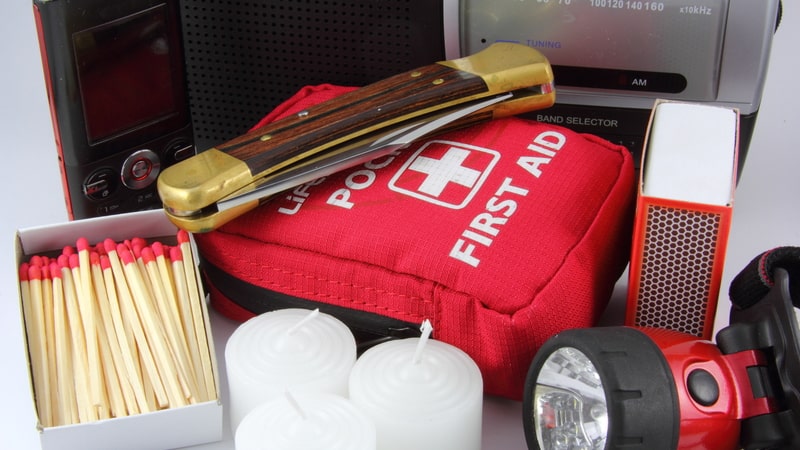Must-Have Items for Your Home Emergency Kit
Are you prepared for severe weather this season?

Emergency season got off to an early start in 2020. Though the Atlantic Hurricane season officially starts on June 1, the first named storm of the season — Tropical Storm Arthur — started forming off the U.S. East Coast on May 17. This April set a record for the number of tornadoes recorded in the U.S., with 351 twisters (and 40 fatalities). And, of course, there’s the COVID-19 pandemic, which is both an emergency of its own and complicates responses to traditional troubles like storms, wildfire, earthquakes.
Now more than ever, you need to be prepared to survive on your own in the case of disaster — days without power, food or water from the tap. And even as much of the country begins to emerge from coronavirus lockdown, don’t rule out new waves of infection that could send people back inside.
Time to assemble a home emergency kit that covers all these scenarios. Have a look even if you think you’re fully prepped. Guidelines change, new technologies emerge — and some of your stash may have deteriorated.
Masks
We’ve recommended masks as part of home emergency kit for years. The fine dust and smoke that accompany many natural disasters, including brush fires and earthquakes, was the main concern. Our go-to was typically a package of disposable N95 or N100 masks like 3M’s 8293 particulate respirator with Cool Flow™ Valve.
These are now the gold standard for coronavirus protection, so if you had some on hand when the pandemic broke, well, lucky you. The COVID-19 pandemic has completely disrupted the supply of medical-grade masks. The Centers for Disease Control now recommends wearing washable cloth face masks when in public, so you are going to want these in your emergency kit as well. The good news is they’re easy enough to find — many clothing retailers have turned to selling their own versions. And there are plenty of online resources showing how to make your own using common household materials like T-shirts, socks and even coffee filters.
Water Filter
Clean, safe water is crucial to human survival, but natural disasters may damage public water or your well supply.
The Department of Homeland Security recommends all homes have enough fresh water on hand to supply one gallon of water per person for three days. And no, soda doesn’t count. Most homes have an emergency water source (whether you realize it or not — remember, you could use the toilet tanks and hot water heater), but to be truly prepared, being able to produce your own clean drinking water can be critical.
A portable water filter (LifeStraw gets excellent ratings from outdoor enthusiasts) is cheap insurance that takes up little space. Stick the LifeStraw personal water filter into any water source, including rain barrels, pools, lakes and rivers. Drink like you would with any straw. The water may not be cool and lemon-flavored, but it will be safe to drink.
LifeStraw’s filtration removes 99.999999% of bacteria (including E. coli), 99.999% of parasites, and 99.999% of micro plastics — because that’s another thing we have to worry about now. It costs $19.95, weighs 2 ounces, has unlimited shelf life, and is rated to treat 1,000 gallons of water.
First-Aid Kit
A first-aid kit is an absolute must-have for any home. You can put together your own, but there are also many companies and organizations that sell complete kits with almost everything you need. The American Red Cross knows a few things about first aid and their kits are a great starting point.
The Department of Homeland Security recommends plastic sheeting with a thickness of 4 to 6 mil (0.004 – 0.006 in) or greater — it’s sold in rolls at hardware stores. Duct tape is available from a variety of producers including Duck Brand, and in a range of interesting patterns. Why not add some color to your recovery efforts?
The combination can be used for everything from securing broken windows to fashioning an emergency shelter, patching a leaking roof, or wrapping up garbage for safe disposal. Plastic sheeting and tape can also be used to protect sensitive electronics or valuable documents from water damage or exposure to dust, or even to make containers for water collection or food storage.
If you are in a situation where air may be contaminated, duct tape and plastic sheeting can be used to seal your windows and doors.
Duct tape is also useful to have for all sorts of other emergency repairs. It may not look pretty, but you can mend torn clothing, or a hole in a shoe or glove. It can be used for temporary car repairs such as patching a leaking hose. Duct tape can even be used to reinforce a sprained ankle or keep a bandage in place.
Waterproof E-reader
A waterproof e-reader has had a place on our home emergency kit list for a while now. You don’t necessarily need to have an e-reader physically stashed in your kit, but you should have one in the house, fully charged and loaded up with emergency content.
Why an e-reader? These things are literally a library in the palm of your hand. Make sure you pick a waterproof model with a built-in light. The Amazon Kindle Paperwhite is $129.99 and makes a great choice.
Add some emergency-specific content. A first aid guide, survival guides, home repair guides, how-to manuals, recipe books, and road maps. You won’t be scrambling to find books — they’re all in one place — and you don’t need to worry about them getting wet, or torn. Plus, you won’t be relying on internet connectivity, whether through your cable provider or cellular network, either of which could be compromised or overloaded. An e-reader is highly portable, the battery will last for weeks on a charge, and the Kindle Paperwhite has its own light for reading in the dark.
Besides the practical applications, having a library of books on hand comes in handy to fend off boredom. So load up the e-reader with some of your favorite titles. Pair it with Bluetooth headphones to listen to audio books. Remember, if the internet is down, so is Netflix.
Multitool
Sure, most people have a tool kit at home, sometimes fairly elaborate ones. But it’s still a good idea to have a multitool stored right in your home emergency kit. That way, critical tools you might need are exactly where you expect them to be, and they’re in a compact form factor that can be slipped in a pocket if you need to go out exploring — or get access to your regular tools.
Multitools can quickly escalate in cost as you add options, but for emergency use you probably don’t need 30 gadgets in the palm of your hand. The Sidekick is a Leatherman bestseller. And it’s a good balance between affordability and capability. It usually runs around $50 and features 14 built-in tools including spring-action pliers, a saw, two knives, screwdrivers, a bottle opener and a can opener.
Emergency Radio (and Flashlight)
Light is a must-have during a power blackout, and radio remains a reliable method of catching up on news and alerts during disasters if cell networks and land lines go down.
A wind-up emergency radio like the ER310 from Midland Radio covers both needs. It picks up AM and FM radio stations, as well as NOAA weather radio (with NOAA extreme weather alerts). The 1400 lux flashlight uses Cree LEDs and lets you adjust brightness to conserve battery life.
Powering everything is a 2600 mAh rechargeable Li-Ion battery that’s good for up to 32 hours of use. While you can quickly recharge it through a USB port, you don’t need power, because the unit includes built-in solar panels and a hand crank. You can also tap that battery in an emergency and top up the battery on your smartphone using the ER310’s USB port.
Explosive Gas Detector
We trust your home is already equipped with smoke detectors and carbon monoxide (CO) detectors. However, you might want to supplement that safety equipment with an explosive gas detector.
Much of the damage done to homes during earthquakes is caused by fires from ruptured natural gas and propane lines. A standard CO detector won’t catch the buildup of these flammable gases, and your smoke detector won’t sound the alarm until the building is actually on fire.
The Kidde Nighthawk KN-COEG-3 includes both CO and explosive gas detection — sounding an 85-decibel alarm so your family can get out of the building in time. It plugs into an AC outlet, and a 9V battery keeps it running during a power outage.
A built-in display shows the current CO levels in the area and displays GAS if natural gas (methane) or propane are detected.
Tough Smartphone Case
Face it, you’d be lost without your smartphone even at the best of times. During a natural disaster, it’s probably your single most valuable tool. Communications, news and updates, contact with friends and family, social media, entertainment, a mini flashlight, your GPS, music, a camera — all in a single device. Before the situation gets risky, make sure that phone will be safe.
Most people choose a minimalist case for their smartphone, and some go caseless for a sleeker look. That’s fine for everyday use, but during a disaster, there’s too much riding on your phone for that. Pick up a sturdy case for your phone and stash it in your emergency kit. There are plenty of options to choose from, and they don’t need to be massive, bulky affairs.
For example, Gear 4’s $49.99 Battersea case (available for popular iPhone, Galaxy and Pixel Phone models) is reasonably slim. It still supports wireless charging but offers 16-foot drop protection and an extra-grippy case surface.
Backup Power
Power is often an issue during emergency situations. There are two degrees of power interruptions. The first is an outage that may last hours, or perhaps a day. The second is a long-term power disruption that occurs when bad weather — hurricane force winds or an ice storm — cause wide-scale damage to power lines.
To keep things running when you’re without power for days or weeks requires a fuel-powered generator. But they have their limitations: Generators big enough to keep your fridge going can be expensive, and none of them can be operated indoors. If you have one as part of your home emergency kit, that’s great. Just make sure that you have plenty of fuel on hand, and that the fuel is fresh. (Gasoline and diesel do go stale; consider using a fuel stabilizer.)
For most people, a portable power station is enough. These use a large battery instead of an engine, but still have an AC outlet so you can run equipment directly. They also have USB ports to charge smartphones and other electronics. They are available in a wide range of capacities and prices; the higher end versions can even run a standard refrigerator for the better part of a day.
Goal Zero is a gold standard for portable power stations. The company’s latest and lightest offering is the $300 YETI 200X. It has 187 watt-hours of power, enough to charge a smartphone 20 times. You can also add an optional solar panel to recharge it.
(C) 2020, KIPLINGER. ALL RIGHTS RESERVED.

